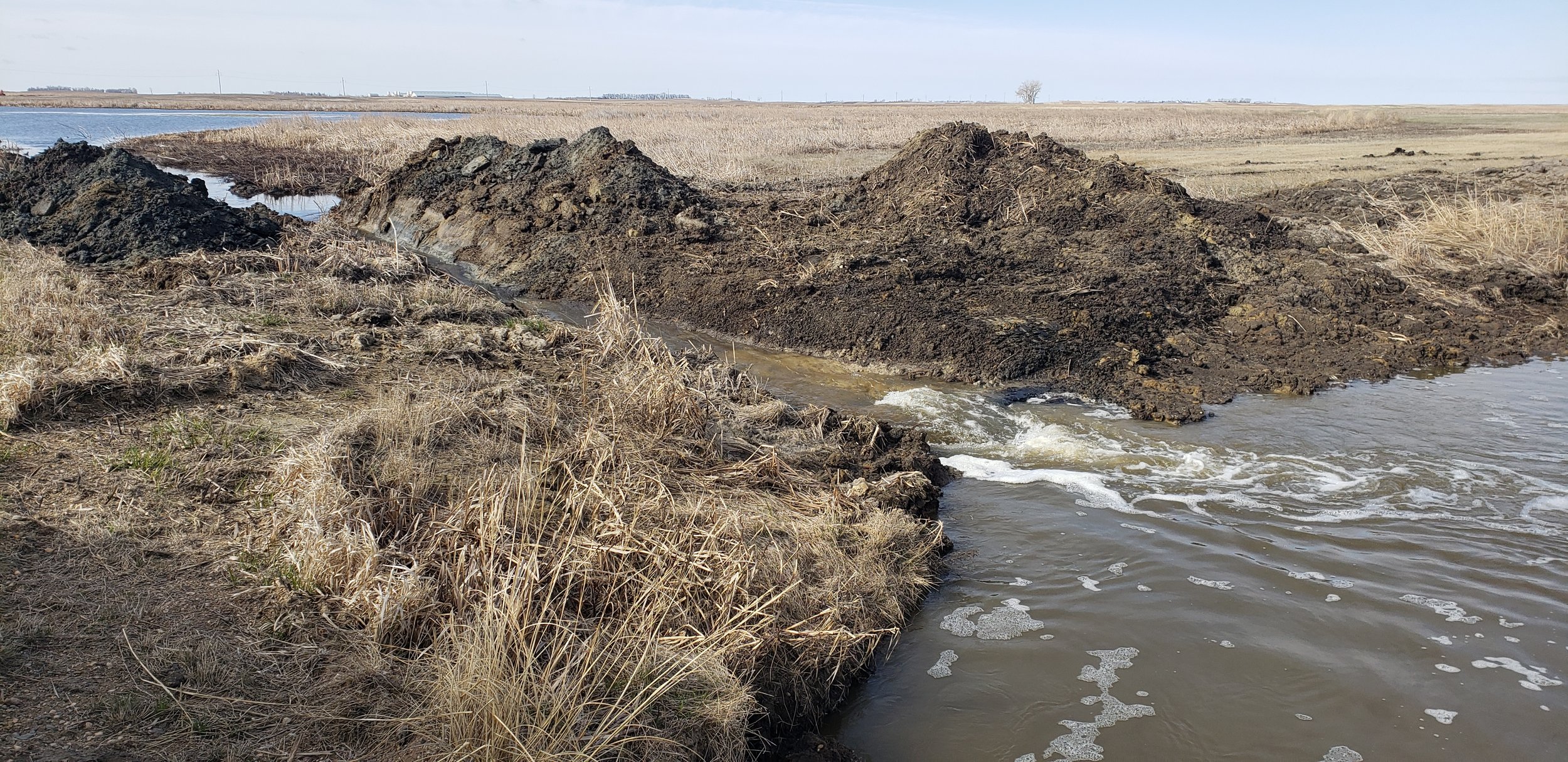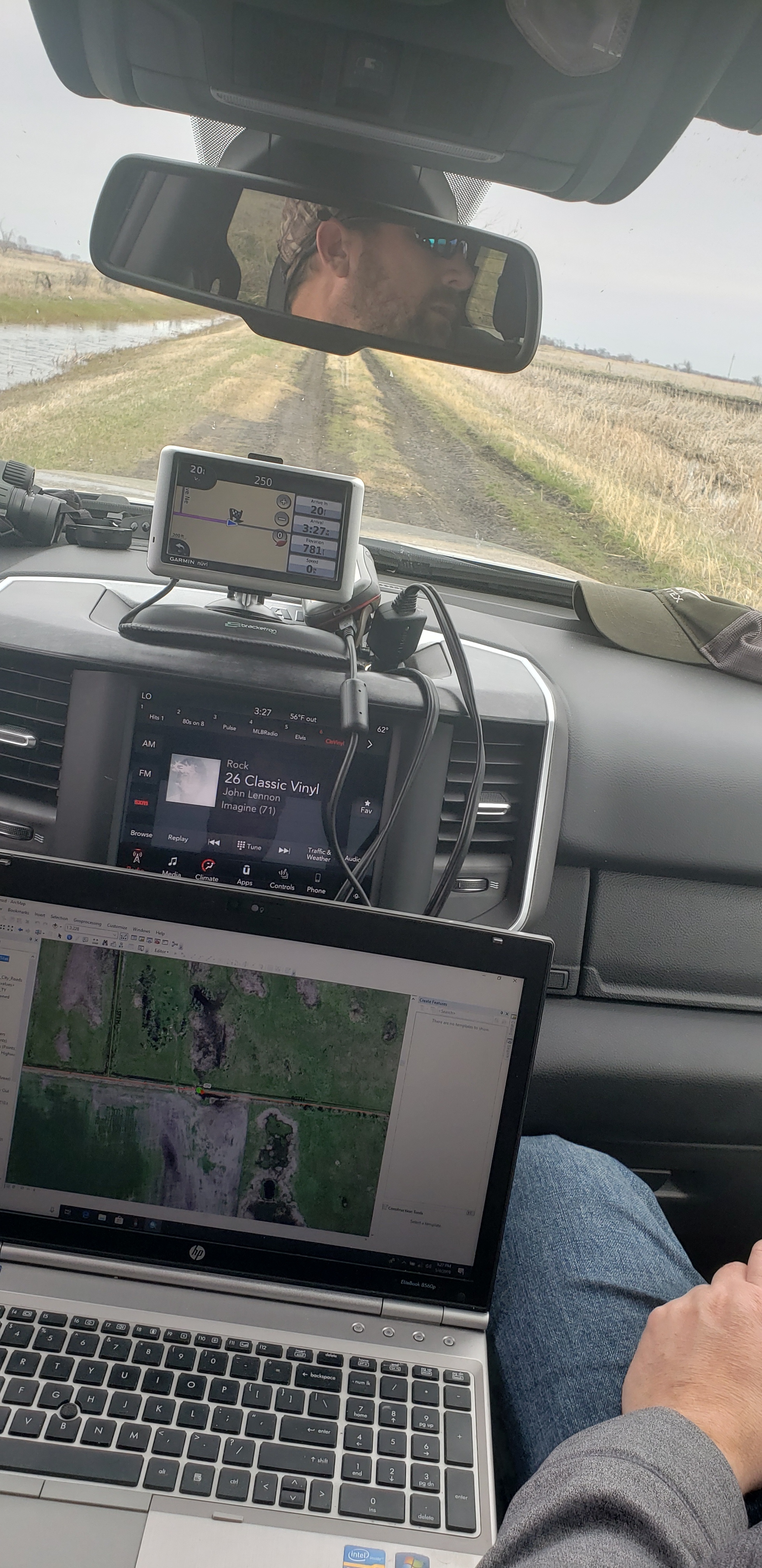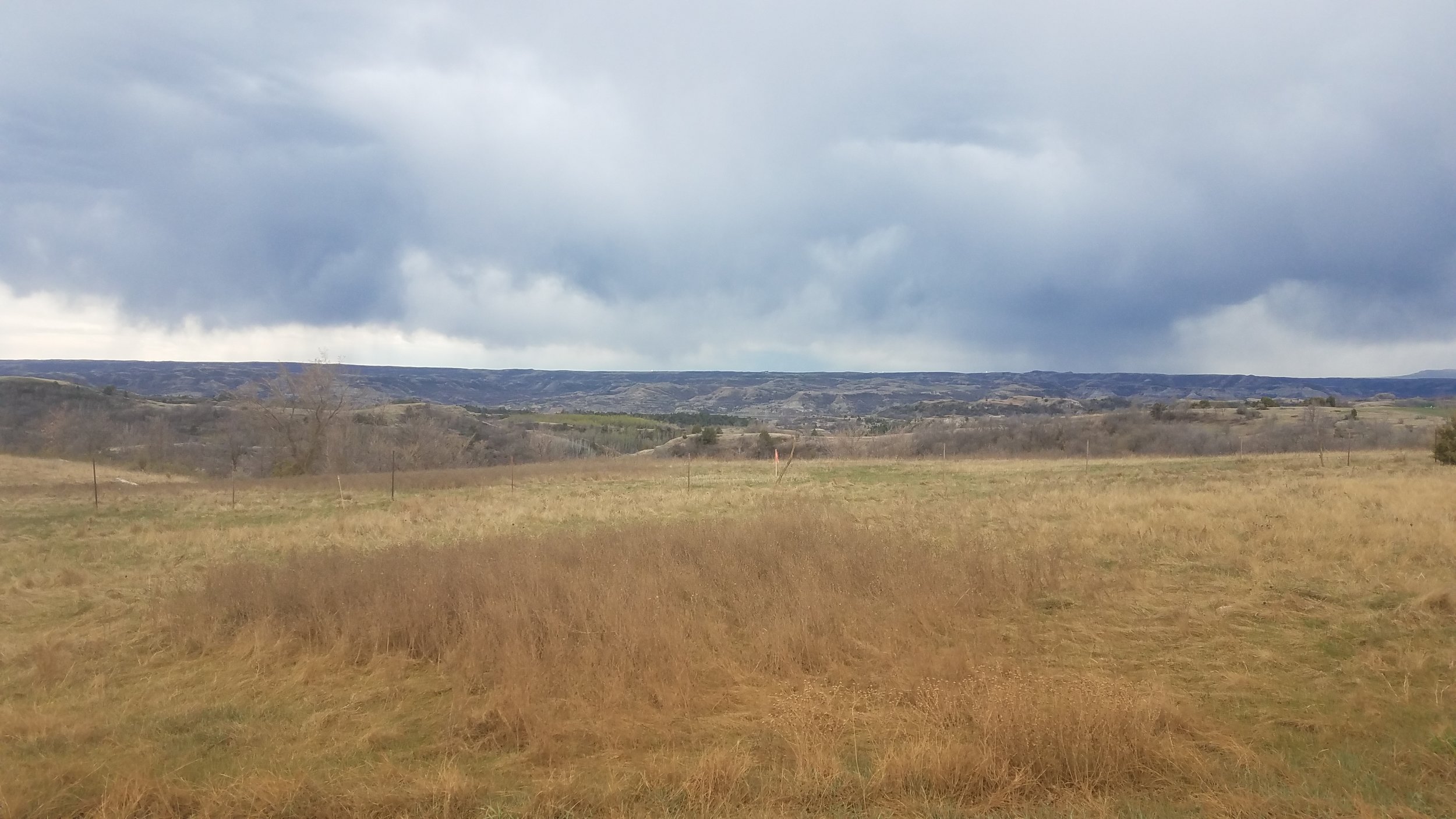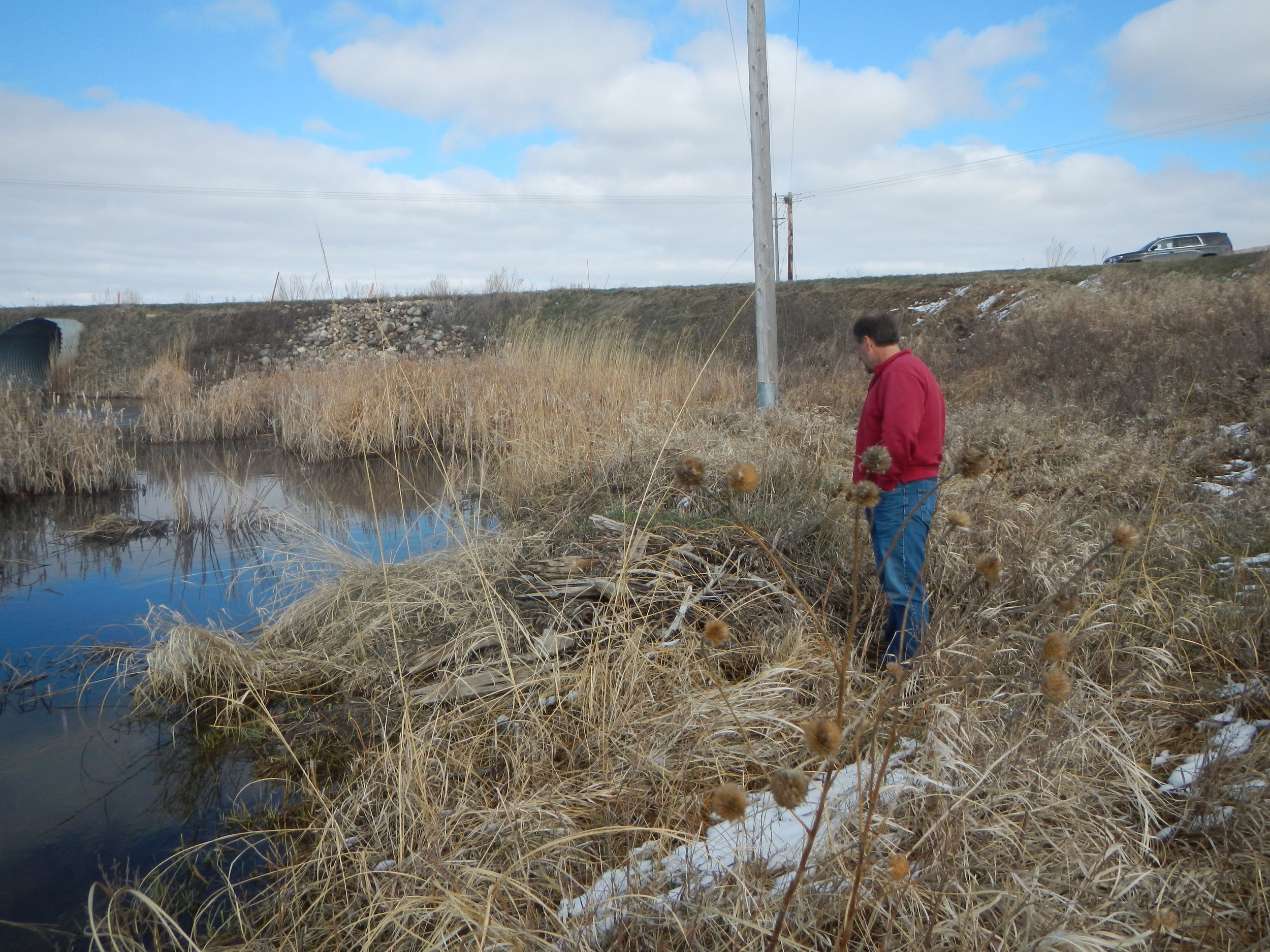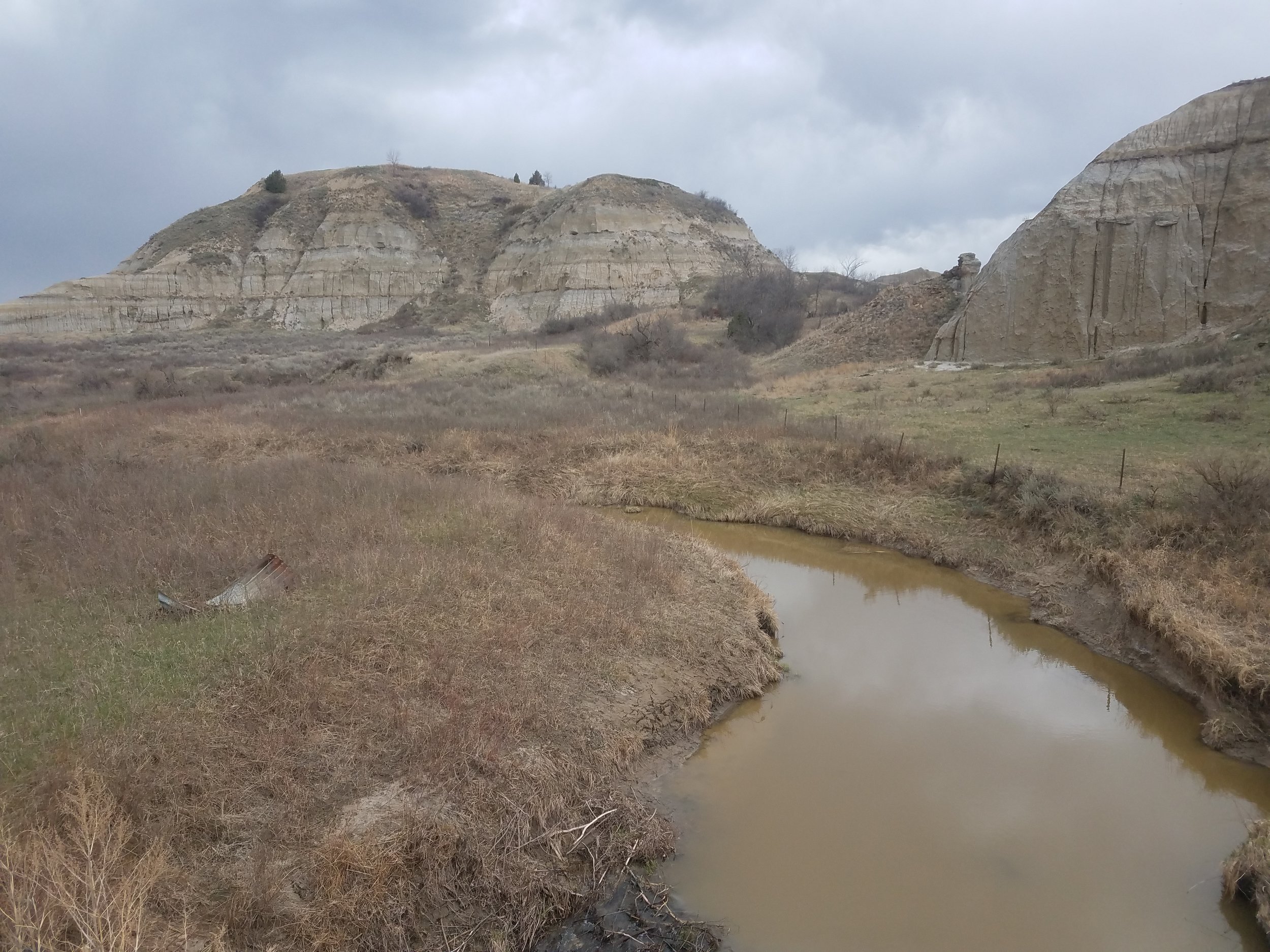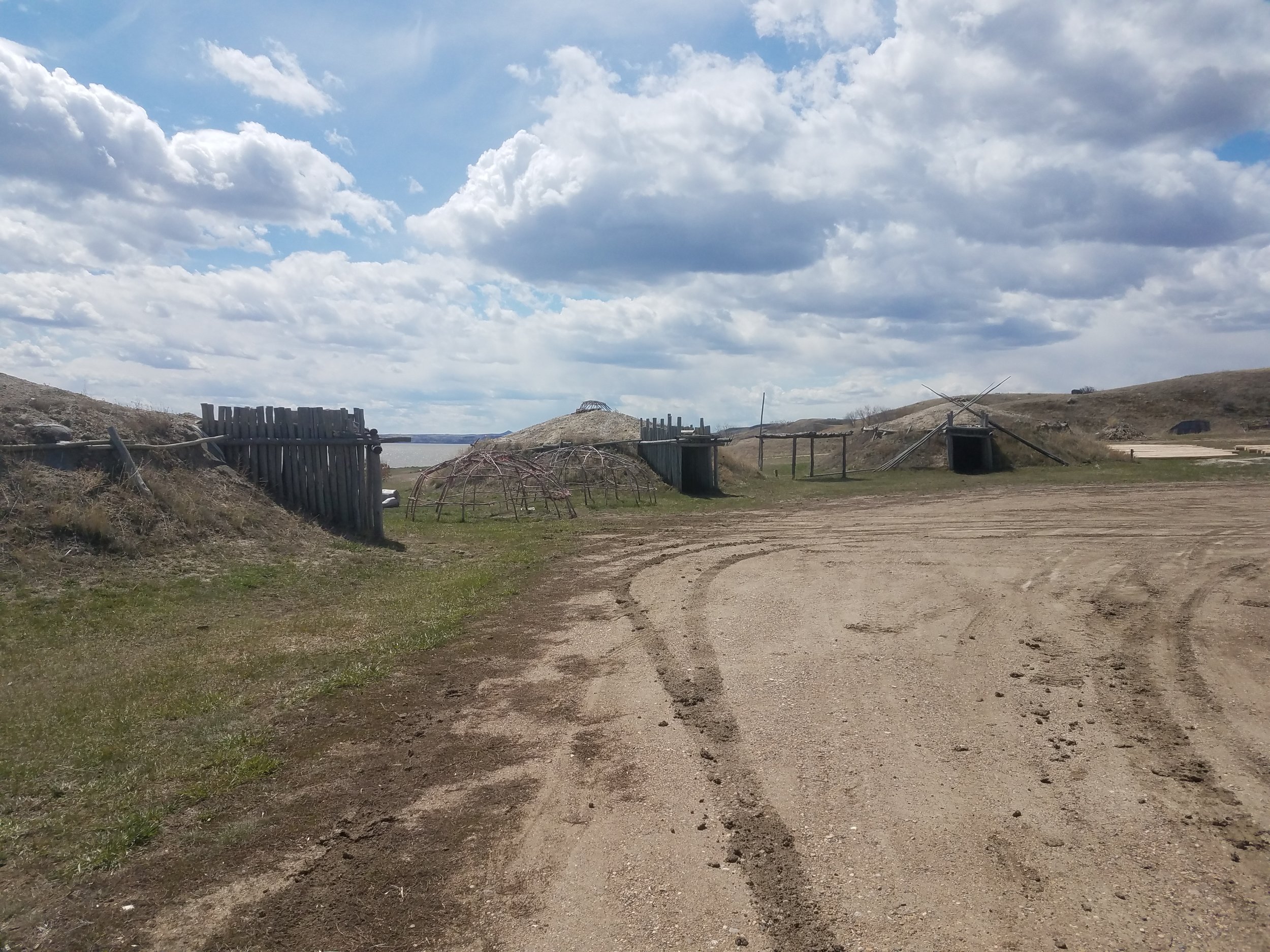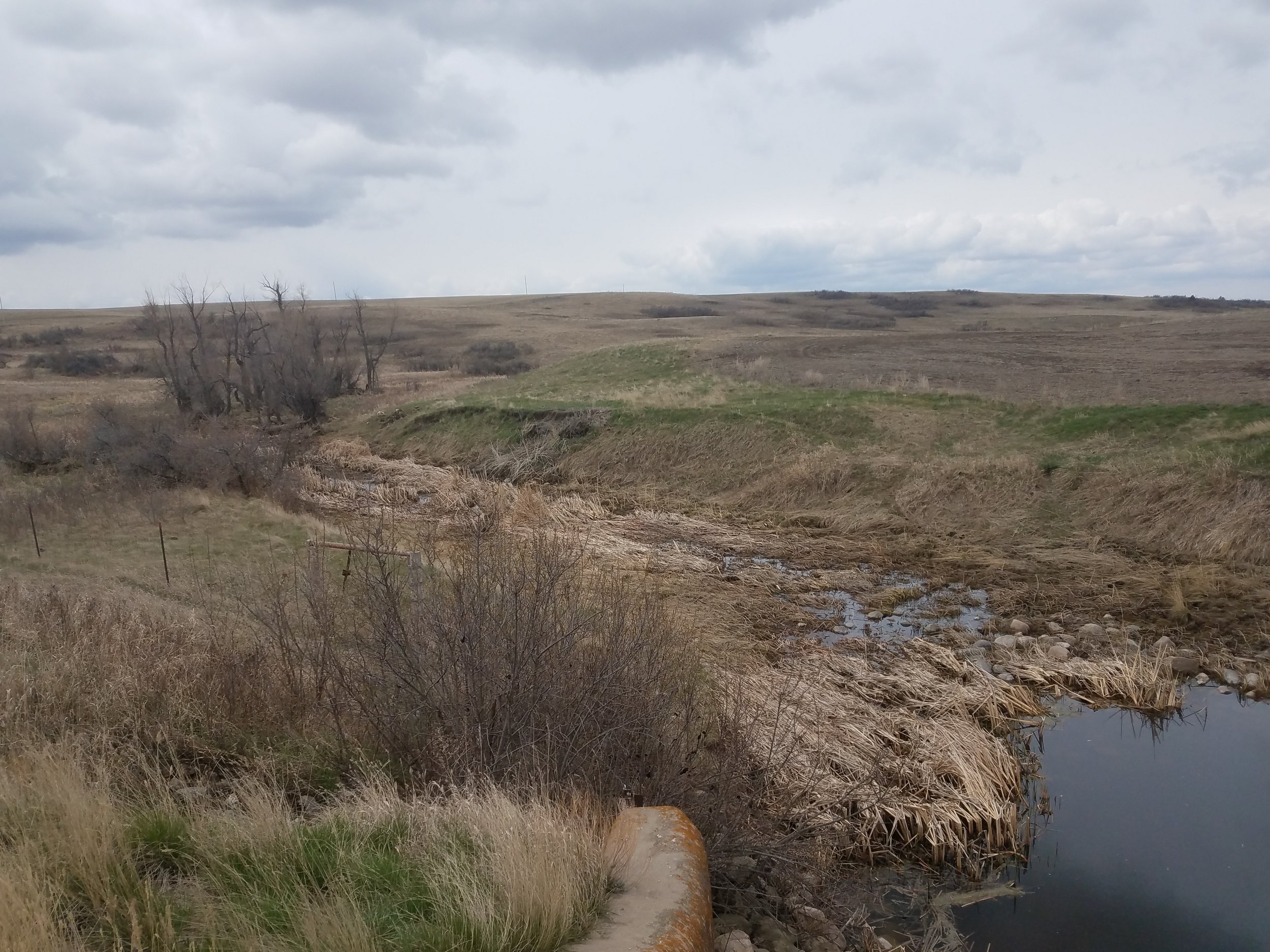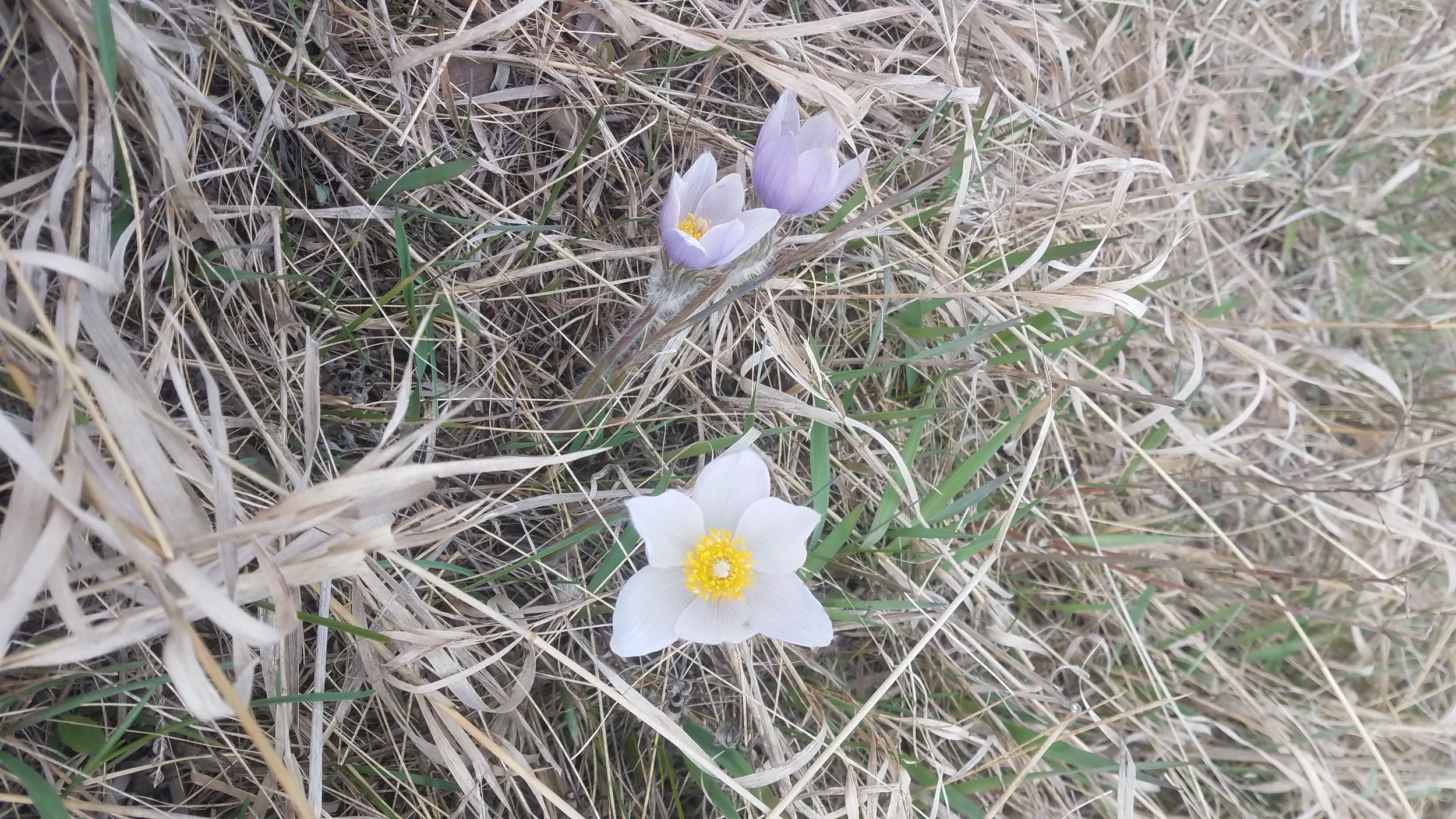
NEWS
One More Round of New Mexico Field Work
From May 13 through 17, GSS staff members Andy Robertson, John Anderson, and Zack Ansell conducted fieldwork as part of a National Wetlands Inventory (NWI) update, consisting of two watersheds in Estancia and San Juan areas of New Mexico. GSS staff met with professionals from the New Mexico Environment Department and US Fish and Wildlife Service to identify different types of wetlands and examine aerial photo signatures to ensure consistent wetland mapping delineations. The main focus of the trip was to look at as many different wetland signatures in the San Juan and Estancia watersheds to assist staff in correctly matching signatures with water regimes.
The team started off in Grants, New Mexico for day 1 of the trip, reviewing pre-mapping sites in the San Juan Watershed, and headed north to Farmington. From Farmington, the team worked east and south across the study area, making it back to Santa Fe to start on the Estancia watershed. The first day in the Estancia area was spent traveling southwest towards Albuquerque. On Thursday, the team worked south from Santa Fe and headed for Capitan, the home of Smokey the Bear. After spending the night in Capitan, GSS staff worked back to the northwest to Albuquerque.








Staff Travel to North Dakota
From May 1 through May 7, GSS staff members Kevin Stark, Nick Lemcke, and Darren Omoth conducted fieldwork as part of the National Wetlands Inventory (NWI) update, consisting of seven counties in the northeast corner of North Dakota. GSS staff met with U.S. Fish and Wildlife Service (USFWS) officials to identify different types of wetlands, discuss wetland conservation techniques, and examine aerial photo signatures to ensure consistent wetland mapping delineations. Much of the focus was on the prairie pothole region, as the study area comprises the central flyway for bird migration and is critical for waterfowl habitat and waterfowl reproduction. Another important focus was on the federal easement program, which is vital to protect wetlands, as the elimination of non-protected wetlands continues due to heavy draining and ditching.
That same week, staff members Andy Robertson, Kevin Benck, and Al Rabine traveled to the Fort Berthold Reservation in northwestern North Dakota. GSS is working with the Three Affiliated Tribes (TAT) on wetland mapping, a wetland program plan, and a wetland functional assessment for reservation lands.
Robertson speaks at National Conference
On Thursday, May 9, GSS Director Andy Robertson gave a presentation at the National Mitigation & Ecosystem Banking Conference in Minneapolis. The 500 attendees included regulators, providers, and users of mitigation and banking services. Andy’s presentation, titled “Potential Consequences of a Narrower WOTUS Definition”, was based on a recent GSS project analyzing proposed changes to the federal Waters of the United States (WOTUS) rule that would remove protections for isolated wetlands across the country. To learn more about our analysis and the impacts of the proposed changes, check out this story map created by GSS Analyst Roger Meyer.
Congratulations, graduates!
It’s graduation weekend here at SMUMN, and some of our student interns are celebrating their accomplishments! While most of our graduating students will be moving on to the next phase in their careers, a few will be staying with us as they continue into graduate programs at SMUMN. Either way, we wish all the best to these graduating interns:
Zack Ansell Angela Soto
Toan Tran Katherine Ethen
Nick Shelquist Shauna Frahm
Maggie Vetch James Loken
Busy Field Season Begins for GSS
In early April, GSS staff began what is going to be a busy spring and summer of travelling for field work to support their wetland mapping projects. Dave Rokus traveled through Utah and New Mexico as part of the U.S. Fish and Wildlife Service's Wetland Status and Trends program. Dave then met up with Andy Robertson and John Anderson in western New Mexico for field work related to a project with the New Mexico Environment Department (NMED) (see photos below). That same week, Andy Nadeau was at Chaco Culture National Historical Park in northwestern New Mexico, meeting with National Park Service staff about a digital file conversion project. This week, Andy Robertson, Kevin Benck, and Al Rabine are at Fort Berthold in North Dakota, working on a wetland project with the area's tribal government. Kevin Stark, Nick Lemcke, and Darren Omoth are also in North Dakota for a week, working on a project with the U.S. Fish and Wildlife Service.
Later in May, the following field trips will take place:
- Eric Lindquist, Peter McColl, and Kevin Stark will travel to Wyoming for a Bureau of Land Management (BLM) project.
- Andy Robertson, John Anderson, and student intern Zack Ansell will travel to central New Mexico for another project with the NMED.
Trips occurring later this summer include:
- Eric Lindquist, Andy Nadeau, and Kevin Stark will travel to Idaho in June for the BLM project.
- Kevin Stark and Eric Lindquist will travel to east-central Alaska in July, also for the BLM project.
- Andy Robertson and Jeff Knopf will travel to the Arctic National Wildlife Refuge in northern Alaska in July for a project with the Fish and Wildlife Service.
GSS Spotlight!
ANDREW SANDOZ
What is your education and professional background?
I am from Harrison, WI and I graduated from Kimberly High school in 2016. Presently, I am finishing up my third year of undergraduate studies at Saint Mary's working, on both a Business Intelligence major and a Finance major. This past summer I had the opportunity to stay on campus and work in the Admissions office as a tour guide for prospective students. That experience was a great way to share the awesome things Saint Mary's has to offer, and allowed me to help start our community garden on campus.
What led you to GIS? More specifically, how did you get to Saint Mary's University of Minnesota (SMUMN) in Winona?
Coming to Saint Mary's was an easy choice for me because five of my relatives have graduated from Saint Mary's. I had never visited campus before deciding to attend but I knew it would be a great fit for me. The bluffs and all of the amazing outdoor recreation opportunities have made my time at Saint Mary's incredibly enjoyable.
Explain briefly a project at GSS you've done that contributed to your overall knowledge and educational experience.
I am currently working on mapping wetlands in North Dakota. Not being from a biology background, I have not had too much class time learning about plants and wetland ecology, but working at GSS has exposed me to so much new information that I would have never had the opportunity to learn in the classroom. The project, in general, has been a great learning opportunity in working with clients and what their needs are for a project in a real business situation. It has been exciting to see what I am being taught in my business coursework come to life outside of the classroom.
How do you see GIS fitting into your future?
GIS will hopefully play a big role in my future. I would like to keep working at GSS and sharpening my skills with the Data Intelligence and GeoAnalytics (DIGA) Master’s program at Saint Mary's. After finishing the DIGA program, I would like to keep working at GSS or do GIS work for cities in southeast Minnesota.
Where can we find you outside of GSS?
Outside of GSS I can usually be found in the community garden on campus pulling weeds or watering the plants while eating kale. When not gardening during the school year I am most likely in the computer lab working on some form of data analytics.
GSS Spotlight!
CALEB KILLIAN
What is your education and professional background?
I got my high school degree from Cochrane-Fountain City school district, and I have 2 semesters of college done (working on my third now).
What led you to GIS? More specifically, how did you get to Saint Mary's University of Minnesota (SMUMN) in Winona?
One of the main reasons I decided to come study here was because I get free tuition since my mother works here. The campus is also beautiful, and I enjoy the size of the community (it's bigger than my high school but still small enough to be relaxing). I was recommended to apply at the GSS offices by my mother, and I followed through with it because the work seemed interesting to me.
Explain briefly a project at GSS you've done that contributed to your overall knowledge and educational experience.
Everything that I do at GSS adds to my overall knowledge. The biggest thing is that I've been taught how to use ArcMap, which is useful for many different things such as surveying populations of areas to decide where to start your business. I can also distinguish bodies of water I see in real life by their attributes, and I have a somewhat extensive knowledge on the types of weeds that will eventually take over and rule humanity.
How do you see GIS fitting into your future?
Although I'm not 100% sure on my major yet, knowing how to use tools such as ArcMap could help me with finding target markets as a marketing major.
Where can we find you outside of GSS?
You can find me roaming around campus with buddies, or doing something outside. Whether it's longboarding, cliff jumping, hiking, or skiing, I always have something to do outdoors. You can also find my artistic endeavors online at https://soundcloud.com/compence , where I upload the music I write and produce.
GSS Spotlight!
PRERNA KAPOOR
What is your education and professional background?
I am from India and graduated in Economics from there before I shifted my base to Minnesota in 2016. At present I am enrolled in the MS program in Data Intelligence and Geo Analytics (DIGA) at Saint Mary's Twin Cities campus. In the past, I have worked as a freelance content writer for a leading student academic magazine and developed content on articles related to Macro-Economics , Environmental Sciences and Financial-Economics. It was a great learning experience for me but I was always inclined towards learning the analytics side of data and I was happy to find Geographic Information Sciences. I definitely plan to explore more opportunities with DIGA and spatial mapping knowledge.
What led you to GIS? More specifically, how did you get to Saint Mary's University of Minnesota (SMUMN)?
I always liked maps and enjoyed discovering new places with the help of maps. I had no idea that spatial data collection can be a field of study altogether and can offer such useful insights to planning and resource management. So, when I was hunting for data analytics courses around, I came across GIS program and was fascinated with the course structure. Hence, I decided to take the next step into it. This University was recommended by a friend and I am very happy with the decision, as the course structure is very well developed and instructors take personal interest in your learning. The class atmosphere is friendly and very interactive, which helps you push your own limits.
Explain briefly a project at GSS you've done that contributed to your overall knowledge and educational experience.
At present I am working on mapping wetlands in North Dakota. I started off by learning manual digitization of linears and polygons following training and attribution standards given by the National Wetlands Inventory, and my responsibility is to come up with an automation process for identification of wetlands in Fort Berthold reservation in North Dakota. Apart from that, there is also good learning on data development to spatial model building and raster/vector data analysis. This project is definitely increasing my knowledge base in GIS and also in Geo Analytics. It is interesting to see how every county has a different geography and needs different base imagery for wetlands identification and image interpretation. It has helped me develop my skill set in ArcGIS as well as Arc Pro.
How do you see GIS fitting into your future?
As I am almost near degree completion and now I think I would want to explore more work opportunities on projects related to Remote Sensing and Imagery Analysis in future. My current project on wetland mapping has been helpful as I can understand how spatial data collection can be put to use and then interpreted for further analysis. I do see myself taking keen interest in environmental conservation and hopefully climate change projects soon. It would definitely be very fulfilling for me.
Where can we find you outside of GSS?
I am graduating this summer so most likely I would be available at the Twin Cities campus. I do like like to stay outdoors for running and cycling at Lake Calhoun in summers. Also exploring new restaurants in the city is something I enjoy a lot.
New Partnership with NPS
GSS was recently awarded a project in collaboration with Chaco Culture National Historical Park (CHCU) in New Mexico. Together, the two entities will work to assess, organize, create metadata, and prepare over 30,000 digital image files for uploading to the public NPGallery photo-viewing portal. This process will make thousands of digital photos spanning several decades available to NPS staff and the general public for the first time.
In addition to the tasks outlined above, GSS will also be drafting two management plan documents for CHCU. The first management document will outline the specific procedures GSS will use to systematically sort and manage the digital images so that the end result conforms to NPS and CHCU expectations. The second written product will be a digital image management plan written specifically for CHCU staff. This document will provide step-by-step details for park staff, collaborators, and volunteers to follow when preparing a new digital image for uploading to NPGallery. It will outline how to attach metadata (i.e., what fields need to be completed, what the standard naming conventions are for each field, etc.), how to credit the image creator/photographer, and will detail where the files should be saved internally. The end result of this effort will hopefully provide CHCU with the resources needed to quickly save and upload digital images so that they are publicly available.
Chetro Ketl, a Chacoan “great house”, at Chaco Culture National Historical Park.
GSS Partners on Clean Water Rule Spatial Analysis
In February of 2017, the Trump administration directed the Administrator of the Environmental Protection Agency (EPA)and the Assistant Secretary of the Army for Civil Works (Assistant Secretary) to revise the definition of Waters of the U.S. (WOTUS). The definition is used to determine which streams, rivers, lakes, coastlines and wetlands are protected from draining and filling under the Clean Water Act. Due to a combination of subsequent rule makings and court challenges, two definitions are currently used in the United States. There are 28 states where waters are defined by the 1986 definition of Waters of the U.S. in combination with guidance developed following the 2006 Rapanos Supreme Court decision and 22 states where waters are defined by the 2015 Clean Water Rule definition.
In December 2018, the EPA and Department of Army published another proposed rule with a new definition of WOTUS to replace both of these. The new proposed rule would remove many waters and wetlands from Clean Water Act protection that are currently protected by both the 2015 and 1986 definitions. There is a clear need for analytical materials, such as a digital map of different watersheds in the U.S. that shows which waters and wetlands are protected and which are not protected under these three scenarios. Such a resource could help elected officials, policy makers and the public understand what waters are currently protected, as well as the extent and impact of the changes proposed by the Trump Administration, so they can comment on the proposed rule and plan for potential future changes in the extent of waters protected under the Clean Water Act.
With grant funding from the Hewlett Foundation, GSS created a geospatial model that predicts the spatial extent of federally protected wetlands and waterways. This model uses three different analysis scenarios:
1. Most Restrictive Scenario - This scenario limits protection of wetlands to those directly adjacent to perennial (permanent) streams/rivers only.
2. Very Restrictive Scenario - This scenario limits protection of wetlands to those adjacent to protected perennial (permanent) and intermittent (seasonal) streams/rivers.
3. Less Restrictive Scenario - This is the least restrictive of the modeled scenarios and limits protection of wetlands to those adjacent to protected perennial, intermittent and ephemeral (temporary) streams, and ditched or channelized streams.
This comparative analysis was completed for three geographically diverse case study watersheds using GIS and publicly available geographic digital data. The methods and communication of results were guided by a project advisory committee made up of science and legal professionals. The results of the analyses in the case study watersheds show that narrowing the scope of federally protected waters would significantly reduce the number of streams, wetlands and wetland acreage protected by the Clean Water Act, leading to a potential loss of benefits provided by wetlands that would no longer be protected under the Act. These benefits include water quality protection, floodwater attenuation, fish habitat and wildlife habitat. The methods and results of this work can be found in the final report and in a story map developed with Esri technology.

